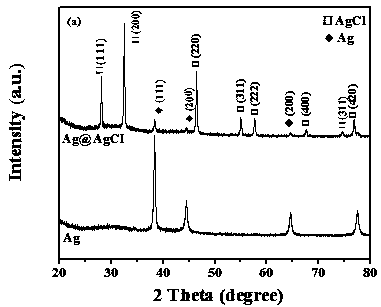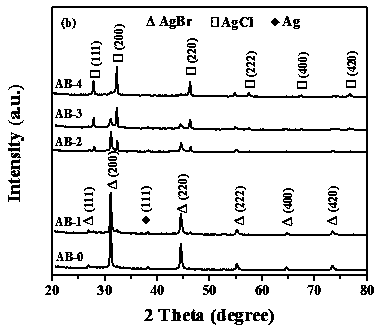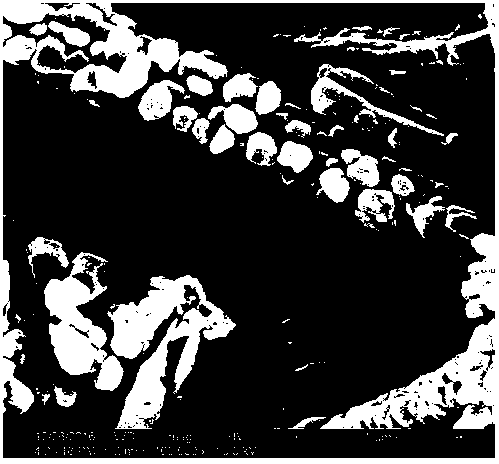Preparation of one-dimensional nanotubular Ag/AgCl/AgBr composite heterojunction visible light catalyst and application thereof
A composite heterojunction, photocatalyst technology, applied in catalyst activation/preparation, physical/chemical process catalyst, nanotechnology, etc., can solve the problem of less research on one-dimensional structure, and achieve easy and efficient photocatalytic performance of equipment and materials , improve the effect of photocatalytic activity
- Summary
- Abstract
- Description
- Claims
- Application Information
AI Technical Summary
Problems solved by technology
Method used
Image
Examples
Embodiment 1
[0029] Weigh 0.3g of copper nitrate trihydrate and dissolve it in 10mL of deionized water, and add it dropwise into a beaker containing 15mol / L 200mL sodium hydroxide solution, then slowly add 2mL of ethylenediamine and 0.5mL of hydrazine hydrate, and then place React in a water bath at 60°C for 2 hours, cool to room temperature, wash, centrifuge, collect, and dissolve the product in 100 mL of deionized water, and disperse it ultrasonically for 5 minutes. Finally, add 100mL of a solution containing 4g of PVP and 100mL of a solution containing 0.5g of silver nitrate, stir and react at room temperature for 2h, wash, centrifuge, collect, and dry in a vacuum oven at 60°C for 24h to obtain silver nanotubes.
Embodiment 2
[0030] Example 2 Weigh 0.05 g of silver nanotubes and 0.03 mg of PVP prepared in Example 1, add them into 50 mL of deionized water, and disperse them ultrasonically for 5 minutes. Prepare 30mL of 15.4mmol / L ferric chloride solution, add it to the above suspension, stir at room temperature for 2h, wash, centrifuge, collect, and dry in a vacuum oven at 60°C for 24h to obtain nanotube Ag / AgCl.
Embodiment 3
[0032] Weigh 0.05 g of Ag / AgCl and 0.03 g of PVP prepared in Example 2, add them into 50 mL of deionized water, and disperse by ultrasonic for 5 min. Weigh 41.5 mg of KBr and add it to the above solution, stir at room temperature for 2 hours, wash, centrifuge, collect, and dry in a vacuum oven at 60°C for 24 hours to obtain nanotube Ag / AgBr (by molar ratio, Br:Cl=10: 0,, the number is AB-0).
PUM
 Login to View More
Login to View More Abstract
Description
Claims
Application Information
 Login to View More
Login to View More - R&D
- Intellectual Property
- Life Sciences
- Materials
- Tech Scout
- Unparalleled Data Quality
- Higher Quality Content
- 60% Fewer Hallucinations
Browse by: Latest US Patents, China's latest patents, Technical Efficacy Thesaurus, Application Domain, Technology Topic, Popular Technical Reports.
© 2025 PatSnap. All rights reserved.Legal|Privacy policy|Modern Slavery Act Transparency Statement|Sitemap|About US| Contact US: help@patsnap.com



